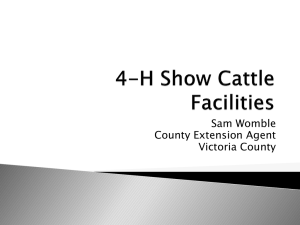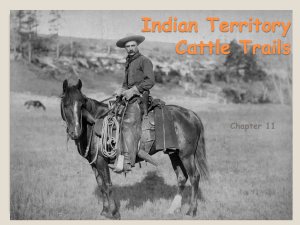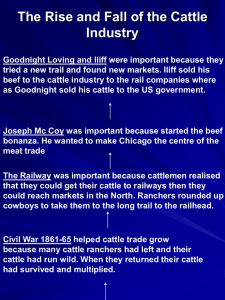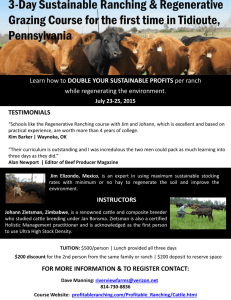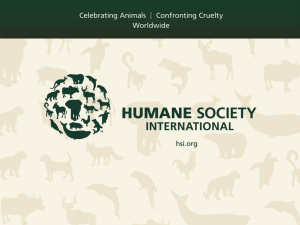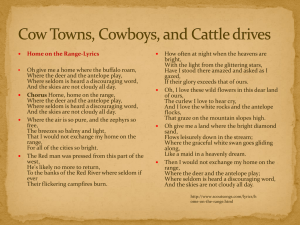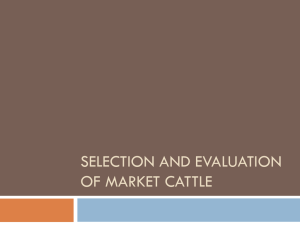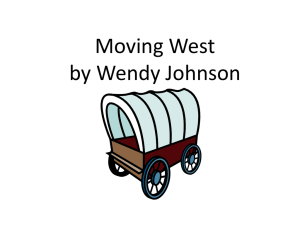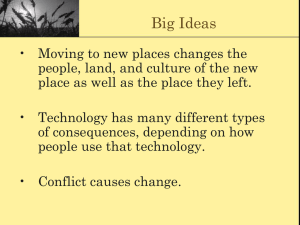Alex & Griffin
advertisement
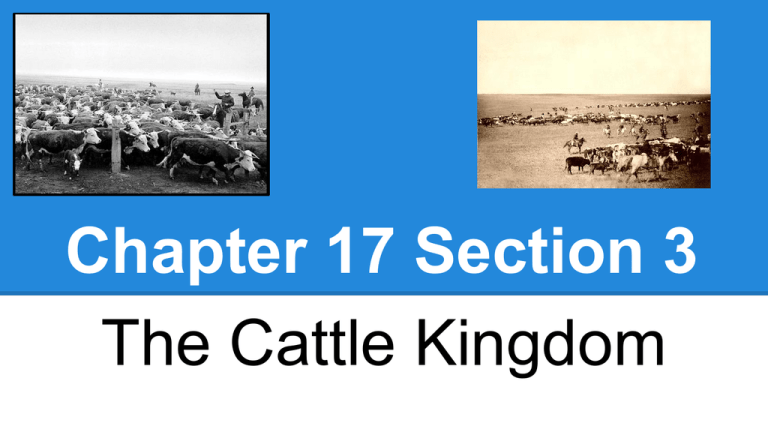
Chapter 17 Section 3 The Cattle Kingdom Vocab ~Open range- unfenced land, p. 590 ~Cattle drive- the herding and moving of cattle, p. 590 ~Persist- to endure; to continue in the face of difficulty, p. 591 ~Vaquero- the Spanish word for cowhand, or cowboy, p. 592 ~Cow town- settlement at the end of a cattle trail, p. 592 ~Myth- story or legend; imaginary, invented story, p. 593 ~Cattle kingdom- the region dominated by the cattle industry and its ranches, trails, and cow towns came to be known as the cattle kingdom, p. 593 The Rise of the Cattle Industry ~For years longhorns, called that because of their long horns, wandered the open range. ~Originally they were strays lost by Spanish ranchers. ~In the 1860s, when railroads were crossing the west, people saw the cows as a source of income. The Rise of the Cattle Industry (2) ~Ranchers in Texas hired cowhands to round up the wild cattle. ~Their destinations were rail lines in Kansas, Missouri, and Wyoming, 1,000 miles away ~The herding of the cattle was called a cattle drive, and they were so grueling that some cowhand brought enough horses that a fresh one was available each day The Rise of the Cattle Industry (3) ~Some of the more used trails, carrying as many as 600,000 cattle each year on drives that lasted 2-3 months were: -Chisholm trail, which ran from Austin to Abilene -Goodnight-loving trail, which ran from Texas to Wyoming. Cattle Trails This picture shows cattle trails such as the Western trail and the Chisholm trail. Life on the Trail ~Cattle drives were long and dangerous, forcing cowhands to develop nerves of steak. ~A couple of the primary dangers were: -Thieves, swamps, and fires. -A river washing cattle away. -Cattle stampedes caused by lightning. ~For all the work, cowhands got less than $1 for a 18 hour day. ~Like in mining, cattle ranching relied on low-paid laborers Life on the Trail (2) ~For all the work, cowhands got less than $1 for a 18 hour day. ~Like in mining, cattle ranching relied on low-paid laborers. ~ Even though the work was hard and the pay was low, cowhands persisted in doing the job. Spanish Roots ~the original cowhands were Spanish and Mexican vaqueros. ~When other people started rounding up cattle, the vaqueros taught them how to ride, rope, and brand the cows. ~Many of the cowhand’s tools have names similar to their spanish roots: -Saddle/Silla de montar -Spurs/espoloñes Spanish Roots (2) -lasso/lazo ~The origins of the cowboy hat came from the Mexican sombrero. ~Nearly one third of cowhands were Mexican. The Wild West ~ Illinois businessman Joseph McCoy founded Abilene, Kansas in 1867 where the Kansa Pacific Railroad met Chisholm Trail ~ McCoy thought that cowboys would want a hot meal and a bath after long months on the trail The Wild West (2) ~ Wichita and Dodge City also sprang up near Abilene ~ Cow Towns had dance halls, saloons, hotels, and restaurants The Wild West (3) ~ Due to the rough life in cow towns many people began believing that the West was a very wild place ~ “Buffalo Bill” is a prime example of the “Wild West” The Wild West (4) ~ Buffalo Bill started a traveling wild west show in 1883 the show consisted plays depicting events of the “Wild West” such as Custer’s ~Annie Oakley performed also and proved she could shoot very well The Wild West (5) ~ There was some basis of fact of the myth of the Wild West ~ But the West was quickly changing Natives were being forced onto reservations and it was becoming more civilized Boom and Bust in the Cattle Kingdom ~ The cattle boom spanned from the 1860s to the 1880s ~ In those two decades herds and markets grew increasing ranchers income, but then the industry collapsed Boom and Bust in the Cattle Kingdom (2) ~ When the cattle boom reached its peak calves could be bought for $5 and steers sold for $60 ~ Ranchers made a lot of money even after expenses for the drives Boom and Bust in the Cattle Kingdom (3) ~ As new breeds of cattle were introduced that produced more meat and contracted less disease profits skyrocketed ~ One company had 800 square miles of ranches in three states Boom and Bust in the Cattle Kingdom(4) ~ More than 7 million cattle were roaming the open range in the mid-1880s ~ Starting in 1886 and 1887 there was a cycle of blazing summers and freezing winters that killed millions of cattle Boom and Bust in the Cattle Kingdom (5) ~ There was an economic depression that put many out of work ~ Beef demand began to drop when the depression hit Boom and Bust in the Cattle Kingdom (6) ~ Sheep began competing against cattle for Prairie land ~ Farmers fenced in land to save their crops ~ Many ranchers were forced to buy expensive fed for their cattle Boom and Bust in the Cattle Kingdom(7) ~ Giant ranches soon faded into smaller ranches that could fed their cattle ~ Railroad lines cut onto ranch and open range land limiting ranchers space ~ The cattle kingdom ended as raising cattle became increasingly difficult Bibliography Page http://www.jonathanfeicht.com/cattle-trails.html http://andspeakingofwhich.blogspot.com/2012/06/your-unfortunate-brother-hanging-of-lh.htm http://tamutimes.tamu.edu/2012/08/15/lightning-temperatures-can-be-hotter-than-the-sun/ http://buckarooleather.blogspot.com/2011/09/trail-drives-of-1800s-cowboys-horses.html http://en.wikipedia.org/wiki/Cattle_drive http://www.deanvigyikan.com/train-illustrations/ http://education.texashistory.unt.edu/lessons/newspapers/cattleKingdom/ http://www.onthechisholmtrail.com/historians/ http://iaanhughes.com/tag/goodnight-loving-trail/ http://www.lemen.com/qa90.html http://www.synergistsaddles.com/horse-saddles/1800s-period-saddles/ http://www.callisters.com/History-of-the-Stetson-Cowboy-Hat_b_250.html http://www.abilenecityhall.com/gallery.aspx?PID=7 http://en.wikipedia.org/wiki/Buffalo_Bill
